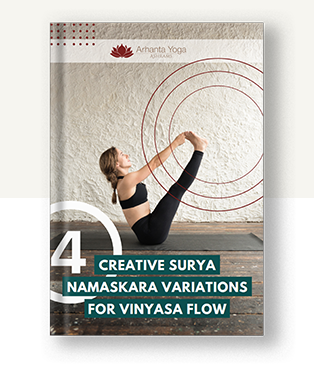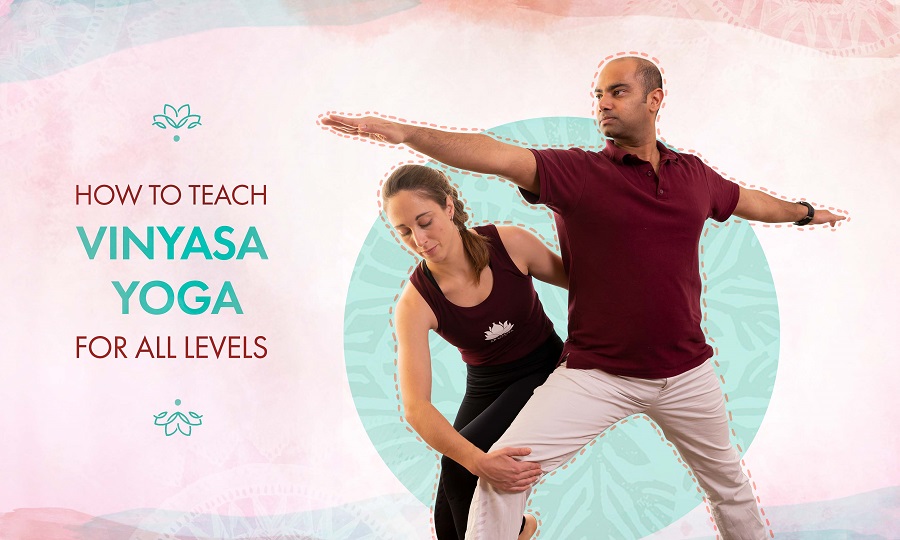Teaching Vinyasa Yoga is not easy. In fact, it is more challenging than Hatha Yoga or Yin Yoga. Why is teaching Vinyasa Yoga challenging? Vinyasa Flow classes are dynamic practices in which we continuously move from pose to pose. Most postures are held for only a few breaths before we make the transition to the next pose. As a teacher, you must be fluent in your instruction while also being quick in detecting and verbally or manually adjusting any misalignments. There are six main challenges and therefore six valuable tips on how to teach Vinyasa Yoga for all levels. Read on to learn about how you can work on mastering them and becoming a skilled Vinyasa Yoga teacher.
How to handle six common challenges with teaching Vinyasa Yoga
1. Be a teacher not an instructor – Get off your mat!
It is easy to become confused between the role of a teacher and the role of an instructor. An instructor is someone who simply provides or explains instructions about how to do an asana or exercise. Mostly an instructor will stand in front, during most of the class and demonstrate the asanas for students to follow. An instructor is more concerned with what to do and how to do it and will follow a set pattern, sequence, or instructions. A yoga teacher though is more concerned with helping each student meet his or her goals of coming to the yoga class. A yoga teacher walks around the class watching, helping, correcting, and adjusting students. You should make a clear choice about whom you wish to be.
Of course, you can make it easier for yourself than that, and many teachers do, especially when they teach Vinyasa Yoga classes. They simply roll out their mat at the front of the classroom and practice along. In times of online classes, this is common and often the only way to teach yoga. But in live classes, you can provide so much more value than just demonstrating and guiding the class from your own mat.
Therefore, we train our teachers to teach away from their own mat. As a teacher, you can only truly assist and help your students if you walk around and adjust your instructions and sequence to the needs and capabilities of your students.
2. Practice what you teach – Before the class
As discussed in the previous point, a teacher doesn’t use his class to do his own asana practice. Test your class sequences on yourself and practice them before you teach. This will help you to detect any illogical or too challenging transitions and will help you to remember the sequence when you teach. The more seasoned a teacher you are, the lesser these practice rounds are necessary. But especially when you introduce a sequence, pose, or transition that you have not practiced yourself in a while, make sure to include it in your own personal practice.
3. Break it down, then build it up
As a teacher, it is your responsibility to ensure a flow and build-up that keeps your students safe from strain or injury. For example, the Surya Namaskara A at the beginning of the class: Many teachers make the mistake to literally ‘jump into it’ right from the start. This can easily lead to common yoga injuries such as a torn hamstring or rotator cuff inflammation.
An experienced teacher instead starts the class with some stabilization and mobilization exercises that prepare the body. From there, the experienced Vinyasa Yoga teacher then builds up the Sun Salutations through an adapted Surya Namaskara A Flow (we call it Easy Surya Namaskara A). So instead of starting with the traditional version of the Sun Salutations, it is a good practice to first break it down into easier parts in order to, from there, build it up again. No matter the level of your students, I would always advise you to start with 3-4 Easy Surya Namaskara A before practicing the traditional and vigorous ‘full’ version.
Similarly, allow yourself and your students to sometimes break the flow and do a short pose or transition ‘workshop’. So, occasionally, interrupt the steady flow of movement to explain important pointers concerning alignment and postural awareness. Remember, it is your job as the teacher to make sure that students do not overextend themselves and continue to listen to their bodies.
Breaking it down and building it up also refers to offering easier versions of poses first before showing your student (if applicable) how to challenge themselves further into the ‘full’ pose.
An excellent example is the Extended-Side Plank (Utthita Parshvakonasana). The final expression of the pose requires open adductors and hamstrings and a good sense of balance. Many students can overdo it and feel knee pain if they just try to ‘jump’ into the full pose.
Be aware that If you offer the full pose first and then say, if you can’t do it you can do the easier version, many students (pride is a fickle thing) will want to prove that they do not need the ‘easier’ version. Therefore, I advise making it a habit to show the safer version first and occasionally give the option to the more challenging ‘full’ version.
Respect your students’ individuality and try to humbly assist them to reach their goals. As a teacher, it is essential that we refrain from having any expectations of what our students could or should be doing. It’s very important, especially in Vinyasa Yoga classes that are often a little more challenging and yang than other styles of yoga, to recognize and encourage our students as the unique individuals that they are.

Get a free copy of our illustrated e-book 4 Surya Namaskara Variations for Vinyasa Yoga
4. Don’t talk too much (it’s not about you!)
In a relatively fast-paced Vinyasa Yoga class the continuous instruction of the teacher can start to feel overwhelming to students. Limit your instructions to what is necessary and make space for silence. Especially beginning yoga teachers struggle with silence and it is a very natural reflex to wanting to fill silences with well-meant but unnecessary talking. You can train yourself to relax into moments of silence and your students will enjoy your class so much more.
Similarly, remember, the class is all about the student’s experience. A yoga class is not about you, the teacher. Teaching—as opposed to instructing—means putting the students’ interests first.
A yoga class isn’t a performance, beauty competition or showcase of your own practice. The more you forget about your voice, your outfit, your presentation, and your performance as a teacher, the better you serve your students.
5. Include a proper cooling down & final relaxation
Especially when teaching a Vinyasa Flow class designed to challenge the students’ stamina and move them through a full-body as well as cardio-vascular work-out, many teachers go full-on from the beginning till the end.
Keep in mind, though, this might be the only class some of your students attend during the entire week. And they should leave the class invigorated, but also relaxed and nourished, rather than drained out, with a huge muscle ache waiting for them the next day. This one class a week is a precious hour when your students can take a break from their work, daily life, and get time for themselves. How can you guarantee that your students leave the class proud of themselves and nourished to take on their daily tasks with positive energy? Next to the previous points discussed above, a proper cooling down and a final relaxation of at least 5 – 10 minutes is the answer.
6. How to teach a well-rounded Vinyasa Yoga class?
There is no official founder of Vinyasa Yoga, it was born out of the Ashtanga Vinyasa Yoga tradition, developed by Patthabi Jois. In the practice of Ashtanga Vinyasa Yoga, breath is coordinated with movement. This Ashtanga Vinyasa Yoga is the source of most all vinyasa, power, and flow style yoga practices that are popular in the West today.
Modern Vinyasa Flow Yoga (also known as Power Yoga and Flow Yoga) is best described as Freestyle Ashtanga Vinyasa as it does not adhere to the rigid structure of Ashtanga Vinyasa set out by K. Pattabhi Jois.
Many Vinyasa Flow classes follow the basic structure of the Ashtanga Primary series, starting with Surya Namaskara A and B but then offering different sequences thereafter. Many classes also closely follow the basic standing sequence of the Ashtanga tradition and the finishing sequence. There are no fixed series of poses. Each class can be different. The basic principle of Vinyasa Yoga (as opposed by Ashtanga Vinyasa Yoga) allows you to explore a changing syllabus of poses. You can explore poses from the Ashtanga first, second and third series in a more accessible manner than in series practice.
Basically, there are as many versions, sequences, and definitions as there are teachers.
Keeping all the principles in mind that in my opinion are essential for teaching Vinyasa Yoga classes for all levels I’d like to share with you a class outline that has served me really well. In my opinion, it is a structure that covers all the essentials and makes your students come back for more every week:
Basic Vinyasa Flow Yoga template for all levels (75 min.):
- Initial relaxation (2-3 minutes before the start of the class)
- Seated or standing meditation or focusing on the breath | 5 min.
- Initial warming-up exercises e.g. cat-cow, arm circles | 5 min.
- Surya Namaskara – 3 Easy Surya Namaskara A, 2 ‘full Surya Namaskara A | 10 min.
- Standing Asana Flow – Woven into Surya Namaskara A and/or B | 15 min.
- Seated or supine core work | 3 min.
- Arm balances (in more challenging classes) | 2 min.
- Prone Backbends - first focusing on building strength than on flexibility |5 min.
- Seated or supine twists |3 min.
- Forward Bends and hip opening - g. Seated Forward Bend and Shoelace Pose | 5 min.
- Inversions sequence to calm/cool down – e.g. Shoulderstand, Plough Pose, Headstand | 7 min.
- Guided final relaxation | 10 min.

Get a free copy of our illustrated e-book 4 Surya Namaskara Variations for Vinyasa Yoga

